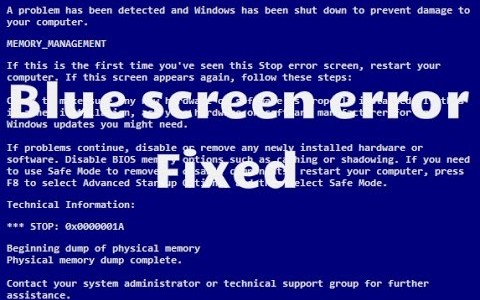Tips To Fix Windows Blue Screen Errors

Tips To Fix Windows Blue Screen Errors
Before troubleshooting a Microsoft Windows blue screen or blue screen error (BSoD), you must first recognize what fault it is, as there are several types of blue screen errors. If you are facing an entire blue or light blue screen with none text or error message, your desktop may consist a bad video card or monitor, arising in only seeing a blue screen. If possible, try to examine if your video card is not supportive or determine if the monitor is poor. If you are experiencing a blue screen and then your desktop instantly reboots without being able to read what is written in the blue screen, follow the steps that are mentioned. If you are not able to get into Windows, boot the desktop into safe mode. Further, if you are unable to boot into Safe Mode, certainly you may have corrupt Windows system files, a faulty memory chip or a corrupted hard drive. You should then run hardware diagnostic tests in order to determine that if the memory or a hard drive is creating the blue screen errors or not.
-
From the Computer or in the Windows Start menu, place a right-click on My Computer.
-
Click on the Properties
-
When you entered into System Properties, click the Advanced tab or the Advanced system settings
-
On the Advanced tab, gently click the Settings button in the Startup and Recovery menu.
-
In the Startup and Recovery window, untamed the Automatically restart check box.
- Finally click on
Blue Screen Errors
Windows NT, 2000, XP, Vista, and earlier versions of Windows have a blue screen fault. These error messages often hold more brief information, and will contain some useful information that can be searched for. If you are not facing a blue screen error, skip to the next Fatal exception section. If you are obtaining a solid blue screen with none white text, you are not experiencing a BSoD. It’s probably an issue with your video card, monitor, or any other hardware. Follow these troubleshooting steps in order to diagnose this problem.
-
Recognize the blue screen by finding a line containing all capital letters with underscores instead of spaces, for example,BAD_POOL_HEADER. Write this information. If you don’t see anything written in all caps with underscores like this, bypass this step.
-
Achieve either the STOP: error message at the top of the error, or in the “Technical Information:” section of the error. For instance, in the above error it’s STOP: 0x00000019… write the first portion of this error message.
-
Finally, if technical information emerges, write down the file and the address.
Once you have all the above information, you can begin with troubleshooting the issue.
Fatal Exceptions
A number of blue screen error messages you will face with older versions of Windows that will be fatal exception error messages or Fatal 0E messages. If you’re blue screen message starts out with A fatal exception 0E … or An exception …, you are experiencing this error.
Leave a Reply